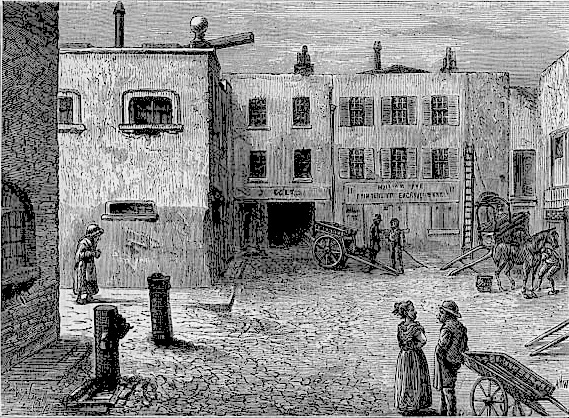Bleeding-heart Yard and Nineteenth-century London Witches March 27, 2013
Author: Beach Combing | in : Modern , trackbackLondon legends rarely stretch back beyond the 1800s which is why this one, which is perhaps based on an Elizabethan legend, is such fun. The extract dates to 1841.
Let any man walk into Cross-street, Hatton-Garden, and from thence into Bleeding-heart Yard, and learn the tales still told and believed of one house in that neighbourhood, and he will ask himself in astonishment if such things can be in the nineteenth century.
Now the house in question is Hatton House and Bleeding-heart Yard the reader should know was named after a pub sign of the Virgin Mary’s Heart pierced with sword, stabat mater etc. But the local rumour mongers could hardly let a name that colourful alone, particularly once the pub disappeared.
The witchcraft of Lady Hatton, the wife of the famous Sir Christopher, so renowned for his elegant dancing in the days of Elizabeth, is as devoutly believed as the Gospels. The room is to be seen where the devil seized her after the expiration of the contract he had made with her, and bore her away bodily to the pit of Tophet: the pump against which he dashed her [brain] is still pointed out, and the spot where her heart was found, after he had torn it out of her bosom with his iron claws, has received the name of Bleeding-heart Yard, in confirmation of the story.
Lady Hatton then was killed by Satan, who ripped her heart out, 27 Jan 1627 after an alliance she had foolishly made to further the ambitions of her husband. The problem with this tale – apart from the obvious difficulties with Lucifer’s sharpened finger nails – is that Lady Hatton actually died in 1646 and was buried in Holborn with full honour. But when our author was writing the legend was already clearly, established. Indeed, it had appeared in the Ingoldsby Legends four years before. Horrible doggerel warning.
Of poor Lady Hatton, it’s needless to say,
No traces have ever been found to this day,
Or the terrible dancer who whisk’d her away;
But out in the court-yard – and just in that part
Where the pump stands – lay bleeding a LARGE HUMAN HEART!
And sundry large stains
Of blood and of brains,
Which had not been wash’d off notwithstanding the rains,
Appear’d on the wood, and the handle, and chains,
As if somebody’s head with a very hard thump,
Had been recently knock’d on the top of the pump.
This pump has naturally disappeared. It almost sounds as if there something red on the pump – rust? – which had led to its entrance into the Bleeding-heart Yard story. But perhaps more interesting is the sequel which is, to say the least, curious.
Whether the horse-shoe still remains upon the door of the haunted house, to keep away other witches, is uncertain; but there it was, twelve or thirteen years ago [1829?]. The writer resided at that time in the house alluded to, and well remembers that more than one old woman begged for admittance repeatedly, to satisfy themselves that it was in its proper place.
This suggests that the horseshoe had been a long standing part of a legend that stretched back at least into the eighteenth century. But what about the spitter?
One poor creature, apparently insane, and clothed in rags, came to the door with a tremendous double-knock, as loud as that of a fashionable footman, and walked straight along the passage to the horse-shoe. Great was the wonderment of the inmates, especially when the woman spat upon the horse-shoe, and expressed her sorrow that she could do no harm while it remained there. After spitting upon, and kicking it again and again, she coolly turned round and left the house, without saying a word to anybody. This poor creature perhaps intended a joke, but the probability is that she imagined herself a witch. In Saffron Hill [just past Hatton Gardens], where she resided, her ignorant neighbours gave her that character, and looked upon her with no little fear and aversion.
There were clearly still witches in London c. 1830. Any other nineteenth-century London witches: drbeachcombing AT yahoo DOT com



